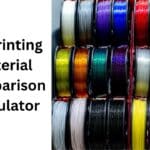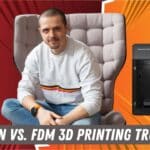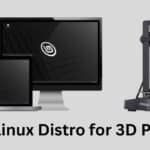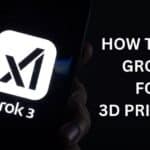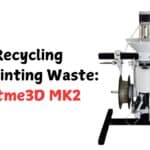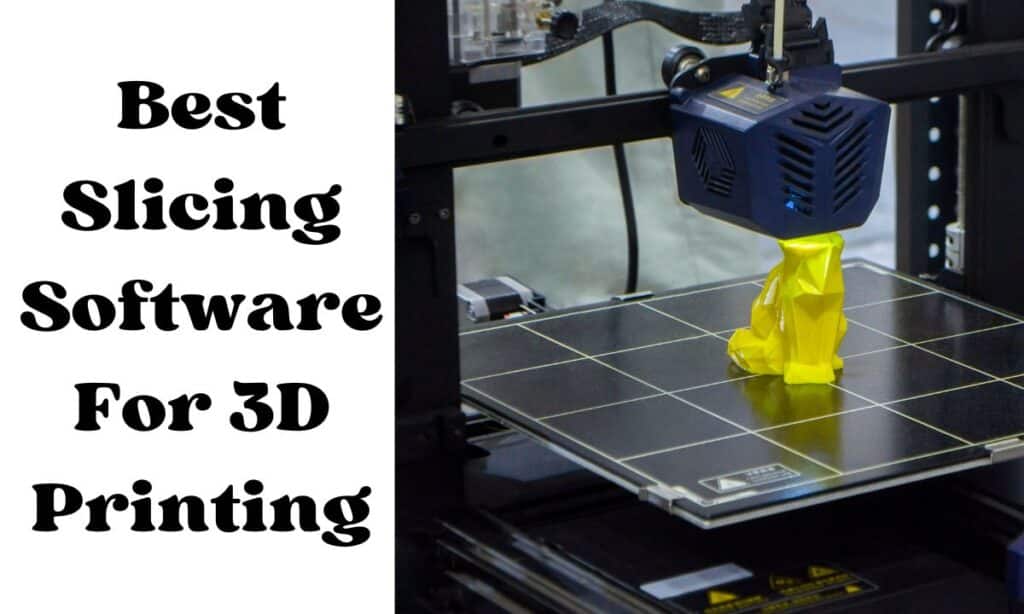
Top slicers like Ultimaker Cura, Simplify3D, and PrusaSlicer shine for ease, customization, or specialization—picking the right one boosts print quality and creativity for any 3D project.
Let’s be honest—3D printing can feel like navigating a maze of technicalities, especially when you first realize that simply loading a 3D model file into your printer isn’t enough. If you’ve ever wondered why your perfectly designed model didn’t print as you envisioned, the answer likely lies in the crucial, yet often overlooked, step of slicing.
Affiliate Disclosure
We participate in Amazon affiliate programs, earning fees from qualifying purchases via links at no extra cost to you. It’s how we keep this blog rolling and my 3D printers buzzing with fresh filament for reviews like this one!
Related: 8 Must-Know File Formats for 3D Printing Enthusiast – Understand file formats for slicing.
What Is Slicing, and Why Does It Matter?
Think as if you’re about to bake a cake, but before you even get started, someone hands you a recipe written in a language only your oven understands. That’s essentially what slicing does—it translates your 3D model into G-code, the specialized language that instructs your printer on how to create each layer, where to move, and when to deposit material. Without a slicer, your printer would have no clue what to do with your design.
Related: Best 3D Printing Software for Industrial Applications – Explore advanced software options.
The Overwhelming World of Slicers
Here’s the catch—there are a lot of slicers out there. From free, open-source tools to advanced, feature-packed options, the sheer number of choices can make your head spin. Which one should you use? Does it even matter? Spoiler alert: It absolutely does.
But before you dive headfirst into downloading every slicer available, know this: The best slicer for a beginner is often the one that comes bundled with your printer or is explicitly recommended by its manufacturer. These programs are designed to work seamlessly with your machine, ensuring that your initial prints are as smooth and error-free as possible. Think of it as training wheels for your 3D printing journey.
Related: How to Use Grok 3 for 3D Printing – Leverage AI for printing workflows.
Why Start Simple?
Using the slicer that accompanies your printer helps you avoid the frustration of early mistakes. Pre-sliced G-code test files provided by manufacturers offer a great starting point, allowing you to see what your printer is capable of under ideal conditions. Once you’ve mastered the basics, you can start experimenting with more advanced slicers to unlock additional features and customization options.
Related: 3D Printing Tips: The Ultimate Janky Yet Effective Beginners Guide – Tips for optimizing slicing settings.
Quick Comparison Table for 13 Best Slicing Software For 3D Printing
Quick Comparison: Best 3D Slicing Software
Updated December 2025| Slicer | Price | Best For | Latest Version | Platforms | Key Features |
|---|---|---|---|---|---|
| Ultimaker Cura | Free | Beginners | 5.11 (Oct 2025) | Win / Mac / Linux | 400+ settings, paint-on seams, marketplace |
| PrusaSlicer | Free | Advanced | 2.9.4 (Nov 2025) | Win / Mac / Linux | Custom supports, 9 beds, scarf seams |
| Simplify3D | $149 | Professionals | 5.x | Win / Mac / Linux | 600+ printers, variable settings, expert support |
| MatterControl | Free | Beginners | 2.0 | Win / Mac | Integrated design, cloud sync, multi-printer |
| Slic3r | Free | Advanced | 1.3.0 | Win / Mac / Linux | Open source, dual extruder, command-line |
| Repetier-Host | Free / Paid | Advanced | Custom | Win / Mac / Linux | Multi-printer control, custom branding |
| KISSlicer | Free / $42 | Prosumers | 23.05 | Win / Mac / Linux | Multi-extruder, profile wizards, fast |
| ideaMaker | Free | Advanced | Latest | Win / Mac | Texture creation, Boolean tools, optimization |
| AstroPrint | Free / Paid | Cloud Users | Cloud | Web / Mobile | Remote control, cloud library, browser-based |
| Bambu Studio | Free | Bambu Users | Latest | Win / Mac / Linux | Multi-color, high-speed, remote control |
| ChiTuBox | Free / $16/mo | Resin | Latest | Win / Mac / Linux | Resin-specific, hollowing, 1200+ profiles |
| Lychee Slicer | Free / Paid | Resin/FDM | Latest | Win / Mac / Linux | Dual mode, 750+ printers, community profiles |
| OrcaSlicer | Free | Advanced | Latest | Win / Mac / Linux | 136+ profiles, stealth mode, calibration tools |
13 Best Slicing Software For 3D Printing
To simplify your search, we’ve curated a list of the five most popular slicers available today. Whether you’re looking for ease of use, advanced settings, or compatibility with multiple printers, there’s something here for everyone.
1. Ultimaker Cura 5.11 (released October 31, 2025)
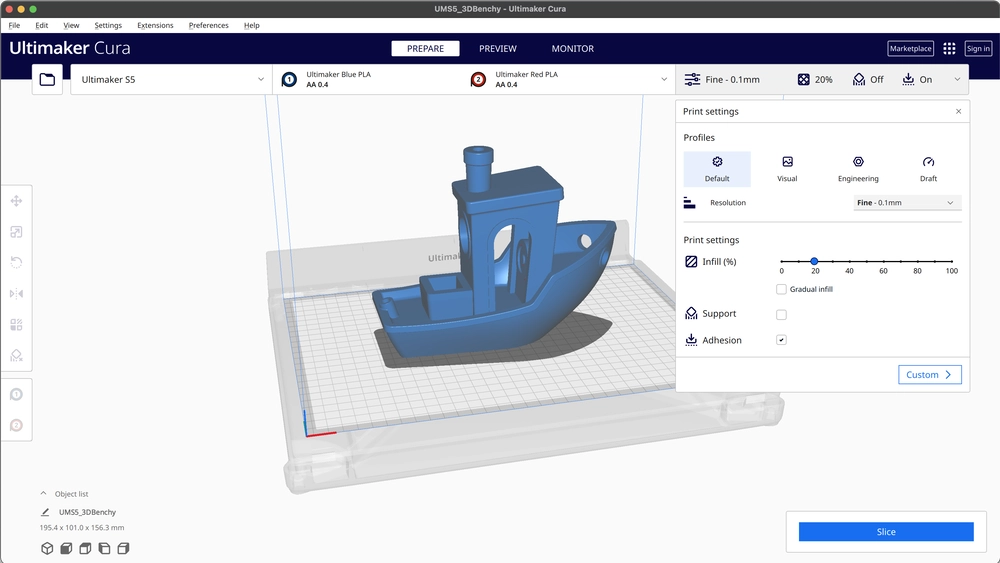
Ultimaker Cura is a free and easy-to-use 3D printing software trusted by millions of users worldwide. With over 400 customizable settings, it allows you to fine-tune your 3D models for optimal slicing and printing results. Whether you’re a beginner or an experienced user, Ultimaker Cura provides the tools you need to achieve high-quality prints.
Key Features
- Powerful Slicing Engine: At the heart of Ultimaker Cura is its advanced open-source slicing engine, developed through years of expert in-house development and user contributions. This engine ensures reliable and efficient slicing for various applications.
- Intent Profiles: With intent profiles, you can print specific applications at the click of a button. These profiles have been tested for thousands of hours to ensure consistent results.
- Custom Mode: For those who want granular control over their prints, the custom mode offers over 400 settings to adjust, allowing for detailed customization based on individual project needs.
- Regular Updates: Ultimaker consistently releases updates that improve features and enhance the overall printing experience, ensuring that users always have access to the latest advancements.
- Paint-on Seam Control Tools: Users can now manually paint seam locations directly onto 3D models using brush tools within the interface. This allows precise control over where layer transitions occur, hiding seams in less visible areas or aligning them along edges. The painting interface works similarly to support painting, letting users mark preferred seam paths that the slicer respects during G-code generation, resulting in cleaner surface finishes.
- Multi-Material Painting with Brush Workflow: Enhanced painting tools enable users to assign different materials to specific regions of a model using intuitive brush strokes. The workflow includes adjustable brush sizes, smart fill options, and material boundary detection. This simplifies multi-material preparation by eliminating the need to split models in CAD software, allowing color and material assignments directly in the slicer with real-time visual feedback.
- Enhanced S6/S8 Support with Expanded Print Cores: Cura 5.11 adds comprehensive support for Ultimaker S6 and S8 printers with expanded compatibility for additional print core configurations. Users can now access optimized profiles for a wider range of material combinations, including engineering-grade filaments. The update includes automatic print core detection, material-specific temperature profiles, and improved dual extrusion coordination for these professional-grade machines.
- Improved Material Profiles for Smoother Surfaces: Updated material profiles incorporate refined temperature curves, fan speed adjustments, and flow rate calibrations specifically tuned for enhanced surface quality. The profiles reduce layer lines and improve overall finish by optimizing parameters like linear advance, coasting, and acceleration values for common filaments. These profiles were developed through extensive testing to balance print speed with surface smoothness.
Integrated Workflow
Ultimaker Cura is designed to integrate seamlessly with all Ultimaker products, making it an essential tool for anyone who owns a 3D printer. It supports CAD plugin integration with popular software like SolidWorks, Siemens NX, and Autodesk Inventor. Compatible file types include STL, OBJ, X3D, 3MF, BMP, GIF, JPG, and PNG, making it versatile for various design workflows.
User-Friendly Experience
Manufacturing doesn’t have to be complicated. Ultimaker Cura simplifies the process so that both experienced and rookie 3D printer users can prepare their models for printing in minutes. Users can easily choose speed and quality settings to start printing right away.
Ultimaker Marketplace
Emphasizing collaboration and openness, Ultimaker has created the Ultimaker Marketplace, where users can download material profiles from leading brands tailored for their applications. This feature helps avoid manual setup when using third-party materials and allows users to download useful plugins that customize their print preparation experience.
Ultimaker Cura Enterprise
For businesses seeking stability and security, Ultimaker Cura Enterprise offers tailored features that ensure a rock-solid infrastructure. It can be deployed across cross-platform systems with regular updates that are thoroughly tested by the community. Each release is independently scanned for vulnerabilities, providing peace of mind regarding security.
2. PrusaSlicer 2.9.4 (released November 7, 2025)

PrusaSlicer 2.9.4, released on September 19, 2024, is an open-source, feature-rich slicing software that has gained popularity among 3D printing enthusiasts. Developed by Prusa Research, this tool is designed to help users export optimal print files for a variety of 3D printers, making it a versatile choice for both beginners and experienced users.
Key Features
- Free and Open-Source: PrusaSlicer is based on Slic3r and benefits from continuous development by a dedicated team at Prusa Research and contributions from the community. This ensures regular updates and feature enhancements.
- User-Friendly Interface: The software features a clear and simple user interface that balances power with ease of use. It is optimized for various screen sizes, making it suitable for both small laptops and high-resolution multi-monitor setups.
- Custom Supports: Users can paint custom supports directly onto their models, allowing for quick adjustments. Support blockers and enforcers can also be added, making it easy to customize support structures as needed.
- Fine-Tuned Material Profiles: PrusaSlicer includes automatic updates for over 250 filament and resin profiles from popular manufacturers. This feature ensures that users have access to the latest settings for optimal print quality.
- STEP File Import: The ability to import STEP files directly allows users to skip the conversion process from CAD models to STL files, streamlining the workflow for engineers and designers.
- Color Painting: For multi-material printing, users can easily color objects using smart fill and brushstroke tools. The software intelligently extends painted regions during slicing to enhance material adhesion.
- Print Time Analysis: PrusaSlicer provides a detailed breakdown of print time by feature in the preview mode, allowing users to adjust settings and see how changes affect print duration.
- Network Printing Capabilities: Users can send G-code directly to their printers via OctoPrint or Repetier Host with a single click. This feature supports advanced functionalities like upload queues and cancellation options.
- MSLA & MMU Support: With the introduction of the Original Prusa SL1 resin printer, PrusaSlicer now includes MSLA mode, making it one of the first high-quality open-source slicers available for resin printing. It also supports multi-material FFF printing with the Original Prusa MMU2S.
- Junction Deviation Integration for Marlin 2: PrusaSlicer now supports Junction Deviation, a motion control algorithm in Marlin 2 firmware that replaces traditional jerk settings. This integration allows the slicer to generate G-code optimized for smoother cornering and curved paths, reducing vibrations and improving print quality. Users can configure Junction Deviation values directly in PrusaSlicer, with the slicer automatically calculating optimal toolpath velocities for compatible printers.
- Multiple Bed Support (Up to 9 Beds): Users can now configure and manage up to nine separate build plates within a single project file. This feature streamlines batch printing workflows by allowing different models or configurations to be prepared simultaneously. Each bed maintains independent settings for placement, orientation, and print parameters. Users can switch between beds instantly, making it easier to organize complex multi-part projects or prepare sequential print jobs.
- Scarf Seams Feature: Scarf seams create gradual, angled transitions at layer start/end points instead of sharp vertical seams. This technique spreads the seam over a larger area, making it significantly less visible on finished prints. The feature works by gradually shifting the seam position across multiple layers, reducing the concentrated appearance of traditional z-seams while maintaining structural integrity. Particularly effective on cylindrical or curved surfaces.
- Improved Time Estimation Algorithms: The time estimation engine has been completely rewritten to account for real-world printer behavior more accurately. The algorithms now factor in acceleration profiles, junction speeds, firmware-specific motion planning, and toolhead mass to predict print durations within 2-5% accuracy. This improvement helps users better plan print schedules and reduces the frustration of inaccurate completion time predictions that plagued earlier versions.
Additional Features
PrusaSlicer offers a variety of additional functionalities that enhance the user experience:
- Adaptive Infills: Users can choose from adaptive infill options like lightning or support cubic patterns.
- Object Manipulation: The software allows for easy manipulation of multiple objects, including group selection and copying/pasting.
- Automatic Model Repairing: PrusaSlicer includes tools for automatically repairing models before slicing, reducing errors during printing.
- Multi-Language Support: The software is available in multiple languages, including English, French, German, Spanish, Polish, and more.
3. Simplify3D
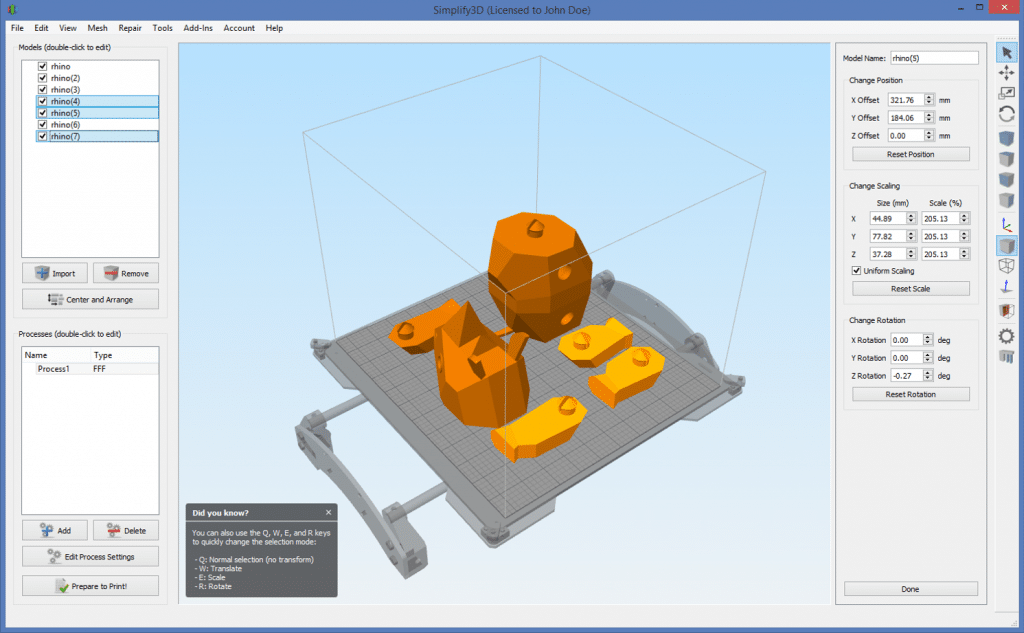
Simplify3D is a premier commercial 3D printing software that has established itself as the preferred choice among engineers, designers, educators, and enthusiasts globally. With over a decade of experience in developing industry-leading additive manufacturing solutions, Simplify3D offers users a professional-grade tool that outperforms freeware and untested alternatives.
Professional Solution
Simplify3D is built specifically for professionals, ensuring reliability and performance in every print job. Unlike many free options, Simplify3D provides a comprehensive suite of features designed to meet the demands of serious 3D printing applications. This software is trusted by users who require consistent and high-quality results from their printers.
Complete Control Over the Printing Process
One of the standout features of Simplify3D is the level of control it offers over the 3D printing process. Users can customize support structures, apply variable settings for different parts, and utilize targeted customizations that unlock new capabilities for their printers. This level of detail allows for intricate designs and complex prints that competitors may struggle to achieve.
Tested and Verified Performance
Simplify3D takes pride in its rigorous testing protocols. The company operates one of the largest collections of 3D printers in the world within its labs, allowing them to continually test and evaluate their software. This commitment to quality ensures that users receive exceptional results right from the start, minimizing trial and error.
Unrivaled Performance
The software boasts best-in-class performance thanks to novel algorithms that significantly enhance processing speed compared to competitors. This efficiency allows users to save time during preparation and iterate faster on their designs, pushing the boundaries of complexity without sacrificing quality.
Universal Compatibility
Simplify3D is compatible with over 600 different 3D printers from numerous popular OEM brands. This universal approach means users do not need to learn a new software program for each printer they acquire, simplifying the workflow across various machines.
Expert Support Team
Users have direct access to a team of 3D printing experts at Simplify3D. This support is invaluable, as the team regularly prints using the same machines as their customers, allowing them to understand the nuances of each printer and help users maximize their results.
The Simplify3D Workflow
Simplify3D streamlines each step of the 3D printing workflow with a range of powerful features:
Import and Repair
Users can efficiently import 3D model files while analyzing geometry for potential mesh errors that could affect print quality. The software’s robust geometric engine can handle large files with millions of triangles, enabling intricate designs without limitations.
Orient and Arrange
The software offers advanced tools for orienting and arranging models on the build platform. Users can optimize build efficiency by nesting multiple parts or adjusting individual components for improved print quality while automatically identifying common issues.
Support Generation
Simplify3D features patented support structure capabilities that allow users to generate superior supports with fine-tuned parameters. Users can customize support locations and shapes quickly, ensuring easy removal after printing without damaging the final part.
Build Customization
The software provides extensive control over print settings, enabling users to define different parameters for specific regions within a single part. This customization helps achieve high-quality prints while minimizing material usage.
Slice and Preview
With over a decade of development, Simplify3D has created one of the fastest slicing engines available. It generates precise machine-specific instructions while incorporating real-world physics to optimize part quality. The advanced Preview Mode offers realistic insights into print properties before starting the job.
Control and Monitor
Simplify3D allows users to control and monitor their printers via USB, WiFi, or Ethernet connections. Users can initiate prints or track sensor readings directly from their desktop, making it easy to manage multiple machines.
Advanced Features for Power Users
Simplify3D includes numerous advanced features designed to enhance printing quality and efficiency:
- Adaptive Layer Height: Optimizes layer thickness based on model topology for improved surface quality.
- Variable Part Settings: Enables different settings for specific regions within a part.
- Automatic Seam Hiding: Selects ideal start points on each layer to hide seams effectively.
- Dynamic Extrusion Sizing: Adjusts extrusion size dynamically for better accuracy in thin features.
- Custom Support Shapes: Allows users to define unique shapes for support structures.
- Dynamic Infill Density: Automatically increases density near surfaces while reducing overall material usage.
- Automatic Mesh Repair: Fixes common mesh errors in real-time during slicing.
- Powerful Scripting Engine: Facilitates custom commands and modifications to output files.
4. MatterControl
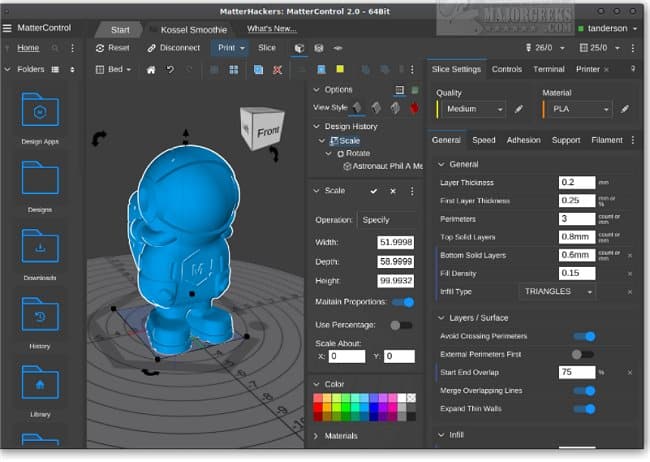
MatterControl is a free, open-source software package that revolutionizes the way users design, prepare, and manage their 3D prints. With its powerful design capabilities and comprehensive print preparation tools, MatterControl stands out as a versatile solution for both beginners and seasoned 3D printing enthusiasts.
Key Features
- Integrated Design and Management: MatterControl is unique in that it combines design, preparation, and management of 3D prints into one cohesive program. This integration simplifies the workflow, allowing users to move seamlessly from concept to completion.
- Powerful Design Tools: The software includes a range of design apps that empower users to personalize and customize their 3D models. Whether you’re starting from scratch or modifying existing designs, MatterControl provides the tools needed to bring your ideas to life.
- Endless Customization: MatterControl offers extensive customization options for slicing and print preparation. Users can take advantage of powerful templates within the Design Apps to kickstart their projects and achieve precise control over every aspect of their prints.
What’s New in MatterControl 2.0
The latest version, MatterControl 2.0, introduces a host of new features and improvements designed to enhance user experience. Users can explore the updated design tools and capabilities through the online documentation or the “What’s New” article available on the MatterHackers website.
User-Friendly Experience
MatterControl is designed with usability in mind. Its intuitive interface allows users to efficiently import 3D model files while analyzing geometry for potential issues that could impact print quality. The software’s powerful geometric engine can handle large files with tens of millions of triangles, making it capable of managing complex designs.
Advanced Features
- Support Generation: MatterControl provides advanced support generation capabilities, allowing users to create custom supports that are easily removable after printing.
- Real-Time Modifications: Users can make real-time adjustments to Z-offsets, print speeds, and extrusion settings directly within the software, enhancing control over the printing process.
- Cloud Sync: With MatterControl’s cloud sync feature, users can access their digital files from anywhere. This ensures that all downloaded designs from the MatterHackers Digital Design Store are readily available regardless of location.
- Multi-Printer Control: The software allows users to control multiple 3D printers simultaneously from a single computer, streamlining operations for those with extensive setups.
System Requirements
To run MatterControl effectively, users should meet the following minimum system requirements:
- Operating System: Windows 10 or macOS 10.x
- Processor: 1 GHz or faster
- RAM: 2 GB (64-bit)
- Hard Disk Space: 6 GB
- Graphics Card: DirectX 9 or later
- Display Resolution: Minimum 800 x 600
For optimal performance, it is recommended to use a system with:
- Processor: 64-bit, 3 GHz or faster
- RAM: 6 GB
- Hard Disk Space: 100 GB
- Graphics Card: DirectX 9 or later
- Display Resolution: Minimum 1024 x 768
Community Engagement
MatterControl thrives on community feedback and contributions. As an open-source platform, developers actively engage with users to understand their needs and improve the software accordingly. Users can choose between stable builds or beta versions to test new features before they are officially released.
Tutorials and User Guides
MatterHackers provides extensive resources for users through tutorials and a comprehensive user guide. These materials cater to different skill levels—from beginner tutorials that cover basic navigation to advanced guides on creating models from scratch using design tools.
Compatibility
MatterControl is designed to work with most open standard desktop 3D printers. It supports popular models such as:
- Pulse Custom 3D Printer
- Ultimaker 2+
- Lulzbot (All models)
- Creality (CR-10 series)
- Prusa i3 Mk2/3/Mini
5. Slic3r

Slic3r is a powerful, open-source slicing software developed by Alessandro Ranellucci, with contributions from a vibrant community of users and developers. It has undergone significant development, with the latest stable release being version 1.3.0. This versatile software allows users to turn 3D models into G-code, enabling a wide range of 3D printing applications.
Key Features
- Multi-Platform Compatibility: Slic3r is available for macOS, Windows, and Linux, making it accessible to a broad audience of 3D printing enthusiasts.
- User-Friendly Interface: The desktop application features a visual preview of toolpaths, advanced configuration management, and the ability to customize G-code with conditional logic. This makes it easy for users to prepare their prints effectively.
- Print Spool Queue: Users can manage print jobs across multiple machines simultaneously or send jobs directly to OctoPrint for remote control.
- Support for Multiple Technologies: Slic3r supports both FDM/FFF and SLA/DLP printing technologies, making it suitable for various types of 3D printers.
Advanced Capabilities
- Modifiers: Users can apply distinct settings to custom regions of their models, allowing for enhanced control over specific areas during printing.
- Command-Line Tool: Slic3r also includes a command-line interface that exposes most features for batch operations and custom integrations. This allows users to generate G-code in bulk, export SVG slices, and perform model transformations.
- libslic3r Library: This C++ library enables developers to build custom applications using Slic3r’s internal algorithms, providing capabilities such as handling 3D models, slicing to vector data, and generating G-code in various formats.
Performance and Speed
Slic3r is known for its fast G-code generation capabilities—up to 100 times faster than other slicing software like Skeinforge. It utilizes multithreading for parallel computation, which significantly speeds up the slicing process, especially for detailed models.
Compatibility with Printers
Slic3r is compatible with a wide range of 3D printers, including popular models from RepRap (like Prusa Mendel and MendelMax), Ultimaker, Makerbot, Lulzbot AO-100, TAZ, and many more. Its universal compatibility ensures that users can easily integrate it into their existing setups without needing extensive adjustments.
Open Source Development
As an open-source project licensed under AGPLv3, Slic3r encourages community involvement in its development. Users can contribute ideas, test new features, and engage in discussions on GitHub or IRC channels dedicated to Slic3r. This collaborative approach helps ensure that the software evolves according to user needs.
Unique Features
- Dual Extruder Support: Slic3r allows users to print with dual or multiple extruders, enabling the creation of colorful objects or the use of support materials effectively.
- Brim Feature: The brim feature enhances adhesion by generating a base flange around objects, which can be easily removed after printing.
- Microlayering: Users can benefit from low layer heights on perimeters while maintaining reasonable print times by selecting thicker infill options.
- Sequential Printing: The built-in plating interface allows users to arrange objects on the build plate easily and print one complete object at a time within a single job.
- Cooling Strategies: Slic3r includes intelligent cooling logic that regulates fan speed and print speed to ensure optimal cooling between layers.
6. Custom Repetier-Host
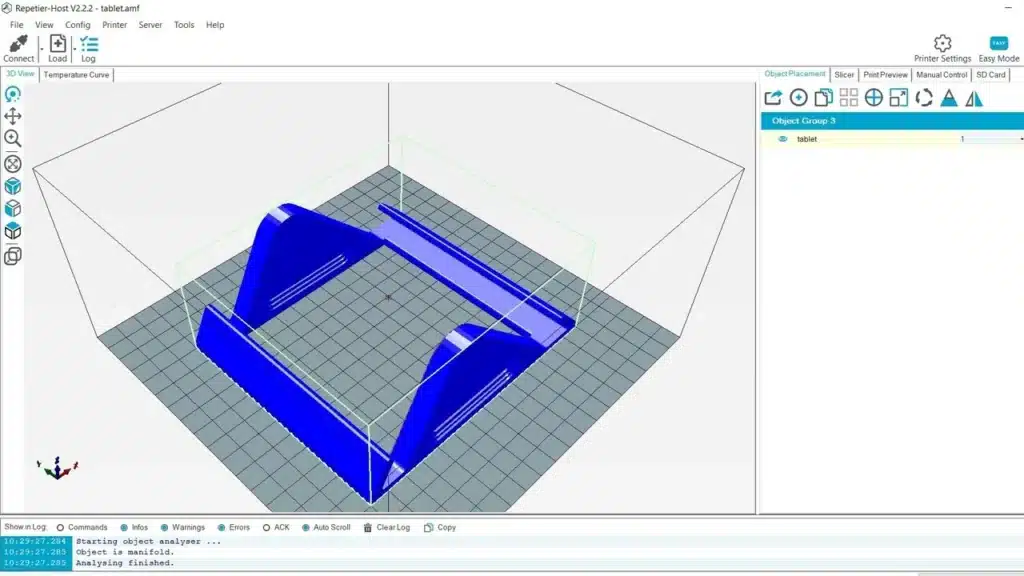
Custom Repetier-Host offers a unique opportunity for businesses and individuals looking to enhance their 3D printing experience with personalized software solutions. This versatile software allows users to manage and control their 3D printers effectively while providing options for branding and customization.
Key Features of Custom Repetier-Host
- Plug & Print Experience: With Custom Repetier-Host, users can enjoy a seamless printing experience right out of the box. The software comes pre-configured with drivers, slicer settings, and printer profiles, allowing users to simply plug in their printer and start printing without extensive setup.
- Branding Opportunities: Businesses can obtain a digitally signed version of Repetier-Host featuring their own branding. This includes custom program icons, splash screens, and the ability to rename the software, enhancing brand visibility and user trust.
- Predefined Settings: The software includes predefined printer configurations and slicer settings tailored to specific printers and filaments. This reduces the likelihood of user errors and support questions, leading to higher customer satisfaction.
- Regular Updates: Users benefit from constant updates that ensure the software remains current with the latest features and improvements as long as support is maintained.
- Customization Options: Additional customization features include:
- A setup wizard that displays the company name.
- Inclusion of specific driver installers.
- Custom help menus with direct links for user assistance.
- Visual representation of the printer shape using STL files.
- The option to display a G-code file on first startup for immediate printing.
Pricing Structure
The cost for a customized version of Repetier-Host is €2,199 for the first year (excluding VAT), with annual renewals priced at €1,190. For an additional €599 per year, users can access further customization options, such as changing program icons and adding logos.
Individual Functions
Repetier-Host has adopted a plugin architecture since version 0.95, allowing for additional menu points and special functions tailored to specific needs. While this service is not included in the standard pricing, it can be negotiated based on individual requirements.
How to Get Started
Interested parties can contact Repetier directly via email at info@repetier.com to discuss their needs for a custom host. The process involves providing necessary data regarding printer configurations, slicer profiles, branding elements, and any desired options. Typically, customized hosts are delivered within two business days after payment.
Access to Source Code
For those seeking even greater flexibility, Repetier offers access to the source code of Repetier-Host for Windows, Linux, and Mac. This option allows developers to create bespoke software solutions tailored specifically to their operational needs.
7. KISSlicer

KISSlicer, or Keep It Simple Slicer, is a versatile and user-friendly slicing software designed for 3D printing. Available in multiple versions—Free, Pro, and Premium—KISSlicer caters to a wide range of users from hobbyists to professionals. It efficiently converts STL files into printer-ready G-code, making it an essential tool for anyone involved in 3D printing.
Key Features
- Cross-Platform Compatibility: KISSlicer is available for various operating systems, including Windows, macOS, and Linux, ensuring that users can access the software regardless of their platform.
- Single Extruder Functionality: The free version of KISSlicer supports single extruder setups, allowing users to perform all necessary slicing functions without any cost. This makes it an excellent choice for beginners who are just starting with 3D printing.
- Multi-Extruder Support: The Pro version unlocks the ability to use multiple extruders, catering to prosumers who require advanced features for more complex prints. This includes the capability to manage multiple materials or colors within a single print job.
- Advanced Slicing Features: KISSlicer incorporates a variety of advanced slicing features that generate high-quality G-code paths for exceptional prints. Users can take advantage of Profile Wizards to quickly set up their printers and materials or download profiles shared by the community.
Recent Updates
KISSlicer has seen continuous improvement with recent updates:
- Version 23.05 (Released May 5, 2023): This update fixed several bugs, added new G-code tokens for better customization, improved arc fitting, and enhanced interface-only rafts.
- Version 22.11 (Released November 21, 2022): Introduced new features such as colorized meshes for premium users, improved multi-material support with a purge octagon for N extruders/1 nozzle systems, and a revamped user interface for easier navigation.
User-Friendly Experience
KISSlicer is designed with simplicity in mind. Its intuitive interface allows users to quickly navigate through settings and configurations. The software provides visual previews of toolpaths, helping users understand how their models will be printed before starting the job.
Customization and Profiles
KISSlicer offers extensive customization options through its Profile Wizards. Users can easily set up their printers and materials by selecting from predefined profiles or creating their own. The community forum is a valuable resource where users can share profiles and tips, enhancing the overall user experience.
8. ideaMaker

ideaMaker is a powerful 3D slicer software developed by Raise3D, designed to prepare files for 3D printing while seamlessly integrating with Raise3D’s printer management platform. This versatile software offers a range of advanced features that enhance the user experience and streamline the printing process.
Key Features
Texture Creation
One of the standout features of ideaMaker is its ability to easily create textures on models. Users can apply different patterns to a selected model’s surface by selecting an image with a desired texture. The software automatically generates a 3D texture based on the image’s greyscale values, allowing for endless customization possibilities without lengthy CAD processing. This feature enables users to create unique iterations of the same STL model effortlessly.
Customizable Support Structures
ideaMaker provides advanced tools for support editing, allowing users to manually adjust support structures generated by the software. Users can create PVA supports, design stable support structures, or develop easy break-away supports. The intuitive interface makes it simple to add or remove supports with just a couple of clicks, ensuring a smooth editing process from various angles and views.
Automatic Optimization
The software employs sophisticated algorithms to automatically compute optimal slicing settings with a single click. This feature balances cost and time without compromising surface quality, adjusting parameters such as layer height and infill structure to reduce filament consumption and printing time.
Variable Settings for Selected Regions
ideaMaker allows users to fine-tune parameters for specific regions of a model, enhancing the mechanical performance of 3D printed parts. Users can define the scope of adjustments based on model groups, layers, or overlapping shapes, providing flexibility in optimizing prints.
Model Modification Tools
With integrated Boolean tools, ideaMaker enables users to carve, split, and combine models directly within the software. This functionality eliminates the need for external CAD software when making adjustments, saving time and effort in the design process.
Community and Resources
ideaMaker includes access to an ideaMaker Library, where users can download free slicing templates tailored for various filaments and printers—both Raise3D products and third-party options. This library fosters community collaboration, allowing users to share slicing templates and contribute to a growing support network.
User-Friendly Interface
The software prioritizes a user-friendly experience with an intuitive interface that simplifies operations. Users can choose between light and dark themes according to their preferences. Additionally, ideaMaker offers an extrusion process simulation that provides detailed previews of the final print result, highlighting different properties such as structure and layer height.
Dual Extrusion Support
For users with dual extrusion capabilities, ideaMaker provides advanced settings designed specifically for printers equipped with dual lifting nozzles or independent dual extruders. This feature enhances productivity while significantly reducing printing time.
9. AstroPrint
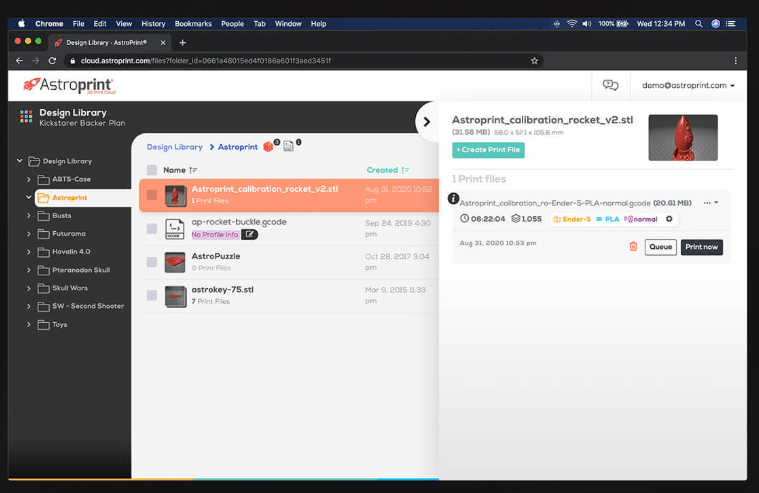
AstroPrint is a comprehensive suite of software products designed to enhance the functionality and usability of 3D printers. With a focus on cloud-based solutions, AstroPrint allows users to manage their 3D printing processes seamlessly from any device, anywhere, at any time.
Key Features
3D Design Cloud Library
AstroPrint provides a secure cloud library for users to store and access their 3D models. Users can upload STL files for cloud-based slicing or pre-sliced G-code files, ensuring that their designs are easily accessible from any device. This feature eliminates the need for local storage and enhances collaboration among users.
Browser-Based Slicing
With AstroPrint, users can slice their models directly from their web browsers without the need for software installation. The online Build Plate STL viewer allows users to add and edit designs easily, providing a simple and intuitive interface for slicing and printing wirelessly.
Remote Control of 3D Printers
AstroPrint offers remote control capabilities through its mobile app or online AstroPrint Center. Users can monitor and control their printers from anywhere, receiving push notifications when prints are completed. This feature enhances convenience and ensures users stay informed about their printing jobs.
Live Print Monitoring
Users can monitor the progress of their prints in real-time, with options to add a camera for live streaming. This allows users to visually inspect the print bed at any time by taking snapshots remotely. Additionally, key temperature readings for the print bed and extruder can be monitored to ensure optimal printing conditions.
Print Queue Management
AstroPrint provides robust print queue management features, allowing users to prioritize print jobs effectively. With Group Queuing access, users can add prints to a shared queue, enabling an admin to decide the order in which prints start on available printers.
Analytics for Improved Print Quality
AstroPrint includes analytics tools that help users track printing trends and performance. Users can monitor statistics such as total print time per printer, filament usage, success versus failed prints by material and printer, and slicer settings. This data helps users make informed decisions to improve print quality over time.
User Permissions Management
Designed for multi-printer and multi-user environments, AstroPrint offers advanced permission settings. Administrators can set over 50 permissions for users, controlling access to features such as slicing, printing, file folders, monitoring, and queue management.
10. Bambu Studio
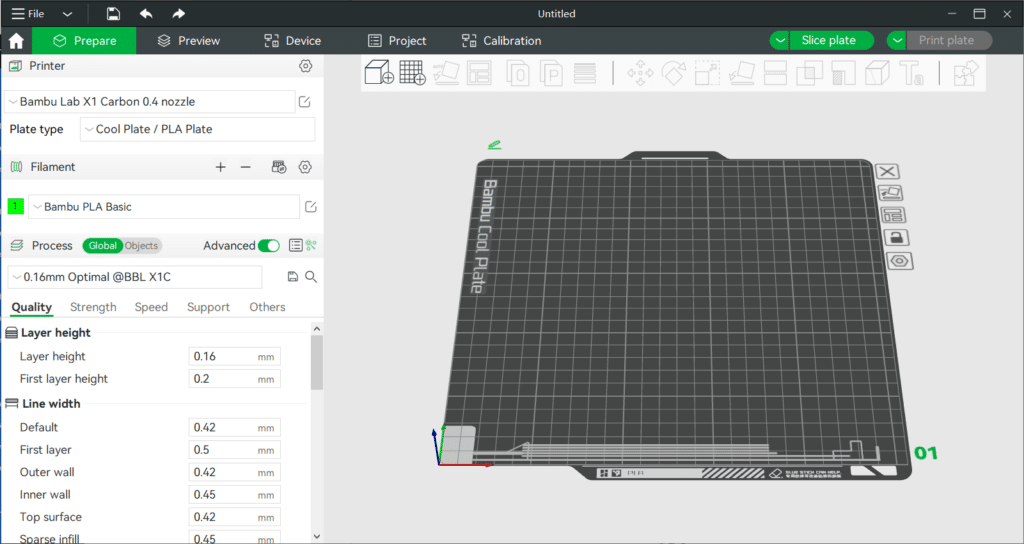
Bambu Studio is an open-source, feature-rich slicing software designed to optimize the 3D printing workflow. With its project-based workflows, systematically optimized slicing algorithms, and user-friendly graphical interface, Bambu Studio offers an incredibly smooth printing experience for users across various platforms.
System Requirements
- Windows: Requires Windows 10 (64-bit) or above.
- Mac: Compatible with macOS 10.15 or above.
- Linux: Available for download from GitHub.
Main Features
Project-Based Workflow
Bambu Studio introduces a leading project-based workflow that allows users to manage their 3D printing projects efficiently. Utilizing the mainstream 3MF project format, it includes features such as Multi-Plate Support, a Project Resource Manager, and Assembly/Part View. These tools significantly enhance the efficiency of both creators and regular users by streamlining the entire process from design to print.
High-Speed Printing with Quality
Achieving high-speed printing while maintaining quality can be challenging, but Bambu Studio excels in this area. The software employs “Arch Move” technology to ensure smooth toolhead movements, reducing vibrations during printing. Additionally, smart cooling features are tailored to each filament type, and an “Auto Slow Down” function helps prevent deformation on overhang walls at high speeds.
Multi-Color Printing
Bambu Studio provides versatile colorizing tools that allow users to create vibrant multi-color models. Users can easily add or remove filaments within a project and use different brushes to colorize their models. The software automatically maps each filament to an AMS slot before printing, eliminating the need for manual spool changes.
Remote Control and Monitoring
With Bambu Studio, users can send print jobs to their printers over WAN/LAN networks and control every aspect of their 3D printers remotely. This feature is particularly useful for those managing multiple printers, as it allows easy switching between devices in the printer list.
STEP Format Support
Bambu Studio supports STEP file formats, which provide more effective information compared to traditional STL files. The high accuracy of STEP files allows for generating extrusion paths as arcs and includes assembly relationships between parts, making it easier to restore assembly views after splitting models.
3D Text Creation
The software includes a 3D Text tool that enables users to create various text shapes within their projects. With dozens of available fonts and support for bold and italic styles, users can personalize their models with ease.
Bambu Lab firmware controversy: Their January 2025 update restricting OrcaSlicer access through authorization controls - this is a major story affecting user choice
11. ChiTuBox

ChiTuBox was specifically designed for SLA/DLP 3D printers, reflecting its origins as a software solution from a company that manufactures mainboards for popular budget resin printers. Initially, ChiTuBox was the sole software option available for many resin 3D printers.
The basic version of ChiTuBox is free but comes with significant limitations, while the pro version, priced at $16 per month, unlocks additional features that can greatly enhance the workflow. Although the free version includes essential tools for effective preparation, the pro version offers advanced functionalities that may be considered costly by some users.
User-Friendly Experience
ChiTuBox caters to users of all experience levels. While its comprehensive system may seem daunting at first, a robust support section and an active community can assist in resolving most issues. New users will find the tooltips helpful, as they provide explanations for more advanced features, enabling quicker adaptation to the software.
Key Features
Model Editing
When working with resin 3D printing, preparing models often requires editing and repairs before slicing. ChiTuBox excels in this area, offering advanced tools to hollow objects and create escape holes for air during printing. However, some common features found in free software, like automatic orientation, are locked behind the pro version.
Resin Material Alliance
The Resin Material Alliance (RMA) serves as an “intelligent resin library” accessible to all ChiTuBox users. This library enhances the software’s capabilities by allowing users to pre-process, slice, and print using various pre-configured material profiles tested by CBD-Tech to improve print success rates. At launch in 2023, it featured over 1,200 profiles for more than 120 types of resin.
Standard Parts Library
ChiTuBox includes a collection of standard models directly within the interface, such as basic shapes and tools like screws and gears. While users could create a similar folder on their computers, having these models readily available in the software adds convenience.
12. Lychee Slicer
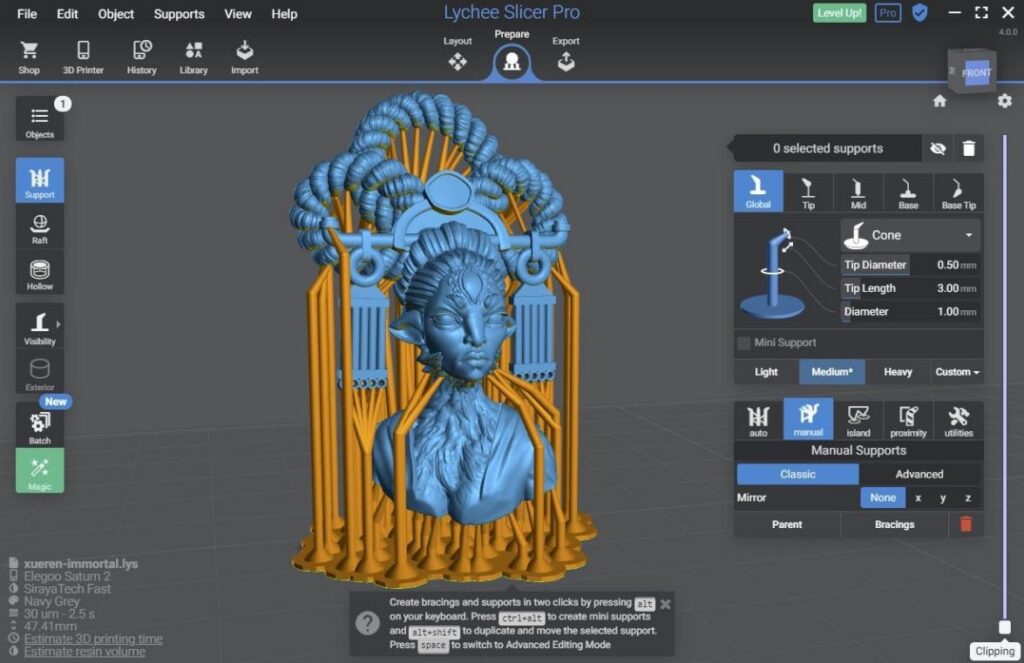
Lychee Slicer is an innovative software designed to streamline the 3D printing process for both resin and filament printing. Whether you’re a novice or an experienced user, Lychee Slicer simplifies every aspect of preparing your models for printing and configuring your printer, ensuring a smooth and enjoyable experience.
Key Features
User-Friendly Interface
Lychee Slicer is known for its intuitive and accessible interface, making it easy for users of all skill levels to navigate the slicing process. The software is designed to save time and effort while enhancing print quality, allowing users to focus on bringing their creative ideas to life.
Dual Printing Modes
Lychee Slicer supports both resin and filament printing, allowing users to switch between modes effortlessly. This flexibility ensures that you can access specific features tailored to each type of printing with just a click.
Real-Time Model Projection
The software provides real-time previews of your models in precise physical scale, helping you avoid surprises during the printing process. This feature allows for quick adjustments before finalizing your print settings.
Community Resin Profiles
Lychee Slicer includes a library of community-shared resin profiles, enabling users to find optimal printing settings for various projects. This collaborative feature enhances the likelihood of successful prints while minimizing waste.
Advanced Support Management
Users can create customized support structures tailored to their specific needs, improving print quality and reducing the risk of failures. The software offers advanced tools for parenting and bracing supports, ensuring strong connections while optimizing material usage.
Additional Features
- Split, Merge & Cut Tools: Quickly modify your 3D models by splitting, cutting, or merging them to fit your design vision.
- Support Painting: Save time by adding supports that automatically follow your cursor’s path, streamlining the support placement process.
- Physical Size Mode: Preview the physical size of your final print directly on-screen, allowing you to make necessary adjustments before printing.
Limitless Creativity
Lychee Slicer caters to a wide range of applications, from figurines and jewelry design to dental models and product prototypes. Its versatility makes it suitable for various creative projects.
Community Engagement
Lychee Slicer boasts a vibrant community of creators who share their work and inspire others. Users can explore a gallery of fantastic creations made with Lychee Slicer, showcasing the software’s capabilities across different projects.
Compatibility
Lychee Slicer is compatible with over 750 popular 3D printer models from leading brands such as Anycubic, Elegoo, Creality, and Phrozen. This broad compatibility ensures that users can easily integrate Lychee Slicer into their existing setups.
13. OrcaSlicer
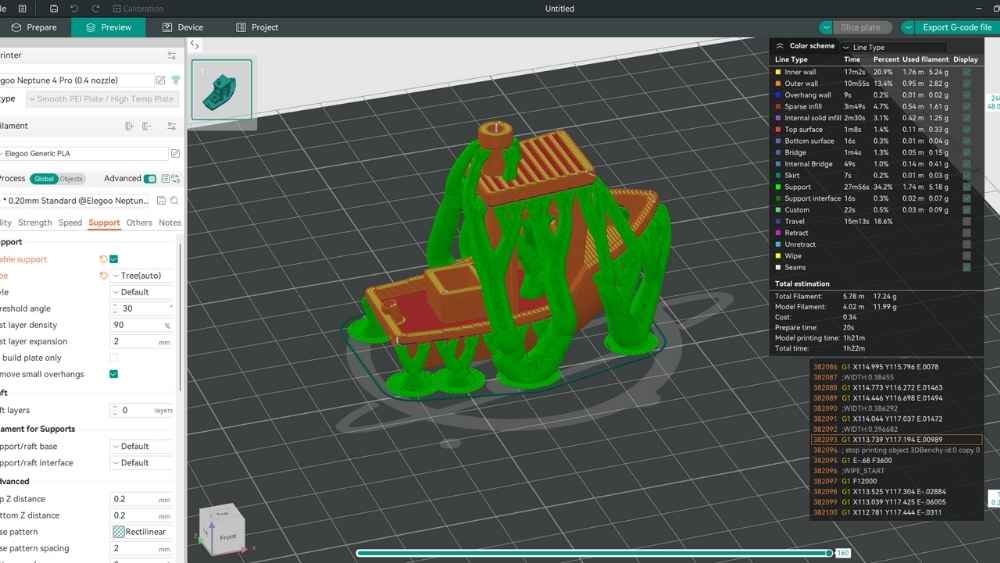
OrcaSlicer is a powerful open-source slicer forked from Bambu Studio, designed to provide advanced features and broad printer compatibility. With over 136 pre-configured printer profiles and extensive customization options, OrcaSlicer has rapidly gained popularity among users seeking alternatives to manufacturer-locked software.
Key Features
- Open Source and Community-Driven: OrcaSlicer is completely free and open-source, with active development driven by community feedback and contributions. Regular updates introduce new features and improvements based on user needs.
- Extensive Printer Compatibility: Pre-configured profiles for over 136 printers including Bambu Lab, Prusa, Voron, Creality, Anycubic, and many others. Universal compatibility allows users to switch between different printers without learning new software.
- Advanced Calibration Tools: Built-in calibration routines for temperature towers, flow rate, pressure advance, and retraction testing. These tools help users optimize settings for specific filaments and printers, resulting in higher print quality.
- Stealth Mode: Privacy-focused feature that prevents telemetry and cloud connections, giving users complete control over their data. Particularly important for users concerned about manufacturer tracking or working in secure environments.
- Device Management Tab: Direct printer control interface for monitoring and managing prints without switching applications. Supports network-connected printers with real-time status updates and remote control capabilities.
Advanced Features
- Soft Support: Generates supports with gradual transitions between support and model, reducing scarring and making removal easier compared to traditional hard supports.
- Auto-Calibration Integration: Supports automatic bed leveling and input shaping calibration for compatible printers, streamlining the setup process.
- Custom G-code Commands: Extensive G-code customization options allow users to fine-tune printer behavior at different stages of the print process.
- Multi-Material Support: Advanced multi-material printing capabilities including intelligent purge tower generation, material-specific settings, and seamless color transitions.
- Arc Fitting: Converts linear G-code movements into smooth arcs where possible, reducing file sizes and improving print quality on curves.
Performance and Workflow
- OrcaSlicer maintains the project-based workflow inherited from Bambu Studio while adding additional functionality. The slicer uses the 3MF file format for projects, preserving all settings and configurations for easy sharing and collaboration.
- The slicing engine delivers fast processing speeds while generating optimized toolpaths. Multi-threaded slicing handles complex models efficiently, and the preview mode provides detailed visualization of each layer including travel moves, retractions, and material usage.
Interface and Usability
- The interface follows a clean, intuitive layout with organized parameter categories. Users can switch between Simple, Advanced, and Expert modes depending on their experience level. Dark and light themes are available for user preference.
- Profile management allows users to save, share, and import custom profiles for specific printers, filaments, and print scenarios. The built-in profile library includes community-tested settings for optimal results.
Compatibility with Bambu Lab
OrcaSlicer works with Bambu Lab printers but operates independently from Bambu’s cloud services. Following Bambu Lab’s January 2025 firmware update requiring authentication for third-party slicers, OrcaSlicer implemented workarounds to maintain functionality while respecting user privacy through Stealth Mode.
Additional Features
- Real-Time Settings Preview: Changes to settings display immediate visual feedback in the preview window, helping users understand the impact of adjustments.
- Custom Support Painting: Manual support placement tools allow users to add supports exactly where needed while blocking unwanted support areas.
- Overhang Detection: Automatic identification of problematic overhangs with visual highlighting, making it easy to determine where supports are necessary.
- Material Database: Extensive material library with pre-configured settings for hundreds of filaments from major manufacturers. Users can also create and share custom material profiles.
- Sequential Printing: Print multiple objects one at a time to reduce the risk of total print failure and minimize stringing between parts.
System Requirements
- Operating System: Windows 10/11 (64-bit), macOS 10.15 or above, Linux
- Processor: 1.5 GHz or faster
- RAM: 4 GB minimum, 8 GB recommended
- Hard Disk Space: 1 GB
- Graphics: OpenGL 2.0 compatible
- Display Resolution: Minimum 1280 x 720
Community and Support
OrcaSlicer benefits from an active community on GitHub, Discord, and various 3D printing forums. Users share profiles, troubleshooting tips, and feature requests that directly influence development priorities. Comprehensive documentation and tutorials help new users get started quickly.
Cross-Platform Compatibility
OrcaSlicer is available for Windows, macOS, and Linux, ensuring accessibility across all major operating systems. The software maintains consistent functionality and interface design across platforms.
Conclusion
This curated list of the 13 best slicing tools highlights the versatility and innovation driving the industry forward. Whether you prioritize user-friendliness (Ultimaker Cura, Lychee Slicer), advanced customization (Simplify3D, PrusaSlicer), or specialized workflows (ChiTuBox for resin, Bambu Studio for multi-material), there’s a solution to elevate your printing experience.
Key trends emerge: open-source platforms like PrusaSlicer and Slic3r thrive on community collaboration, while cloud-based tools like AstroPrint and MatterControl emphasize accessibility and remote management. Commercial options such as Simplify3D cater to professionals with rigorous testing and unparalleled control, whereas free tools like Cura democratize high-quality slicing for all.
When choosing software, consider factors like printer compatibility, material support, and your technical proficiency. Experimentation is key—many programs offer free versions or trials, allowing you to discover which aligns best with your workflow. Ultimately, the right slicer not only optimizes print quality and efficiency but also unlocks creative potential, transforming digital designs into tangible innovations.
As 3D printing technology evolves, so too will these tools, driven by user feedback and technological advancements. Stay curious, explore updates, and leverage the vibrant communities behind these platforms to push the boundaries of what’s possible in additive manufacturing.
Frequently Asked Questions
What is 3D printer slicing software?
3D printer slicing software converts 3D model files (STL, OBJ, 3MF) into G-code instructions that your printer can understand. It divides the model into horizontal layers and generates toolpaths for movement, extrusion, temperature, and supports. Without a slicer, your printer can’t process models—it’s the essential “translator” in the workflow.
Which is the best free 3D printing slicer in 2025?
PrusaSlicer remains the top overall free slicer for its balance of features and reliability across printers.
For beginners, UltiMaker Cura is unbeatable with its intuitive interface and 1,000+ profiles.
High-speed users prefer Orca Slicer for advanced calibration and tree supports.
Do I need different slicers for resin vs. FDM printers?
Yes—FDM (filament) slicers like PrusaSlicer focus on extrusion and infill, while resin (SLA/DLP) needs specialized tools for exposure times, hollowing, and drainage holes. Use Lychee Slicer for seamless dual-mode support, or ChiTuBox for dedicated resin with 1,200+ profiles.
Should I use my printer manufacturer’s slicer or a third-party one?
Start with the manufacturer’s (e.g., Bambu Studio for Bambu Lab, Creality Print for K1) for optimized profiles and ease. Switch to third-party like Orca or Cura for more features and broader compatibility once you’re comfortable.
What’s the difference between Cura and PrusaSlicer?
Cura shines for beginners with a simple UI, color-coded settings (green/yellow/red for difficulty), and a huge plugin marketplace.
PrusaSlicer offers deeper control for advanced users, including paintable supports, variable layers, and multi-bed printing—ideal for precision.
Is paid slicing software worth it in 2025?
Rarely for most users—free options like Orca and Prusa cover 99% of needs with frequent updates. Paid like Simplify3D ($149) suits pros needing legacy support or extreme tweaks, but it’s outdated; ChiTuBox Pro ($169/yr) adds value for resin hollowing.
Can I use multiple slicers for the same printer?
Yes—many pros switch based on needs (e.g., Cura for quick prototypes, Orca for calibration-heavy prints). All output standard G-code, so compatibility isn’t an issue. Test profiles to match your setup.
What’s the latest on Bambu Lab and Orca Slicer compatibility in 2025?
Tensions peaked in early 2025 with Bambu Lab’s firmware requiring authentication for third-party slicers like Orca, citing security. Orca’s dev (SoftFever) rejected “Bambu Connect,” adding “Stealth Mode” for LAN-only workarounds to preserve privacy and open-source access. Users can still slice in Orca and transfer via SD card; cloud features are limited. Community backlash led to partial reversals, but expect ongoing debates—LAN mode keeps full functionality.


